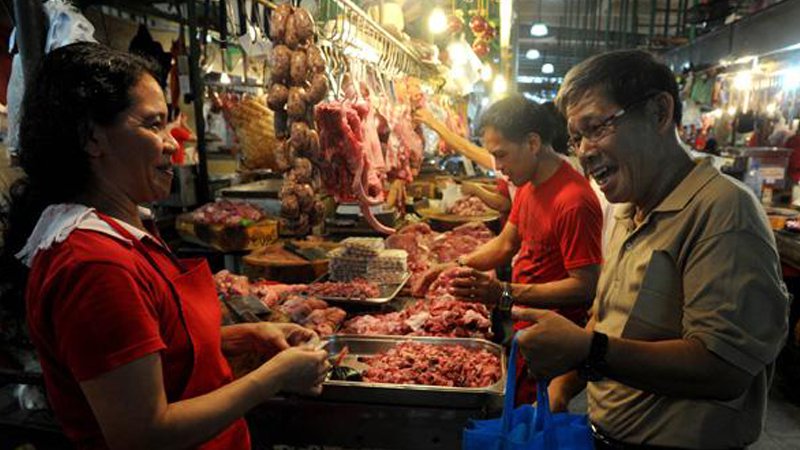Inflation eased to 3.1% in May – BSP

Meat sold at a wet market in Metro Manila (AFP FILE PHOTO)
MANILA — Inflation eased to a four-month low of 3.1 percent in May as upticks in average prices of both food and non-food items slowed, the government reported Tuesday.
The rate of increase in prices of basic goods last month was the lowest since January’s 2.7 percent but higher than the 1.6 percent registered in May 2016.
As of the end of May, inflation averaged 3.1 percent.
In a text message to reporters, Bangko Sentral ng Pilipinas Governor Amando M. Tetangco Jr. attributed last month’s lower inflation rate to “slower increments in the prices of food, beverages and tobacco items.”
“The inflation print further supports our view of manageable inflation that is expected to fall within the target range for this year and next,” Tetangco said. The government targets inflation to settle within the range of 2-4 percent in 2017.
In a statement, state planning agency National Economic and Development Authority said the decline in headline inflation last May “bodes well for the country’s economy in the near term.”
“Inflation for the food and non-alcoholic beverages subgroup eased to 3.8 percent from the previous month’s 4.2 percent. This is due to slower price adjustments in vegetables, fish, oils and fats, as well as sugar, jam, honey, chocolate and confectionery. Slowdown in the prices of vegetables, in particular, was attributed to the resilience of crops in northern Philippines that withstood unfavorable weather and frost earlier this year,” NEDA said.
However, NEDA said “other food commodities like fruits, meat and rice recorded faster price increases in May,” with inflation of the Filipino staple food accelerating to 2.4 percent.
“These trends bear watching, given the significant impact of food prices on the poor. The amendment of domestic laws to reflect the expiry of the World Trade Organization waiver on rice quotas should also be pursued,” Socioeconomic Planning Secretary Ernesto M. Pernia said.
Non-food inflation, meanwhile, declined to 2.5 percent last month from 2.7 percent in April, which NEDA attributed to “slower price adjustments for clothing and footwear, furnishing, household equipment, health, transport, communication, and recreation and culture” as well as oil products.
In a note to clients, London-based economic research firm Capital Economics said “the fall in inflation [last May] adds weight to our view that it is now past its peak.”
“May marked the first fall in headline inflation in nine months. The main factor behind the drop last month was a decline in fuel and electricity inflation, which fell to 8 percent from 8.5 percent in April. Looking ahead, we think fuel inflation has further to fall as the low base caused by last year’s slump in oil prices continues to drop out of the annual comparison,” Capital Economics said.
“With headline inflation likely to fall back further in the coming months, we think that the central bank in the Philippines will be in little hurry to raise rates. Unlike the consensus, which is anticipating two 25-basis point rate hikes this year, we expect rates to remain on hold for the rest of this year,” according to Capital Economics. SFM

